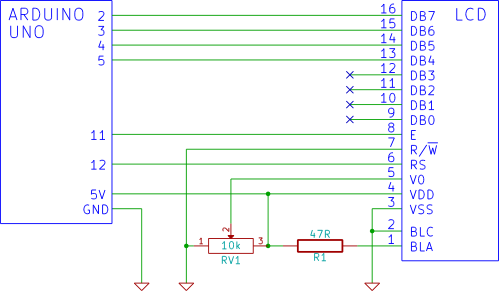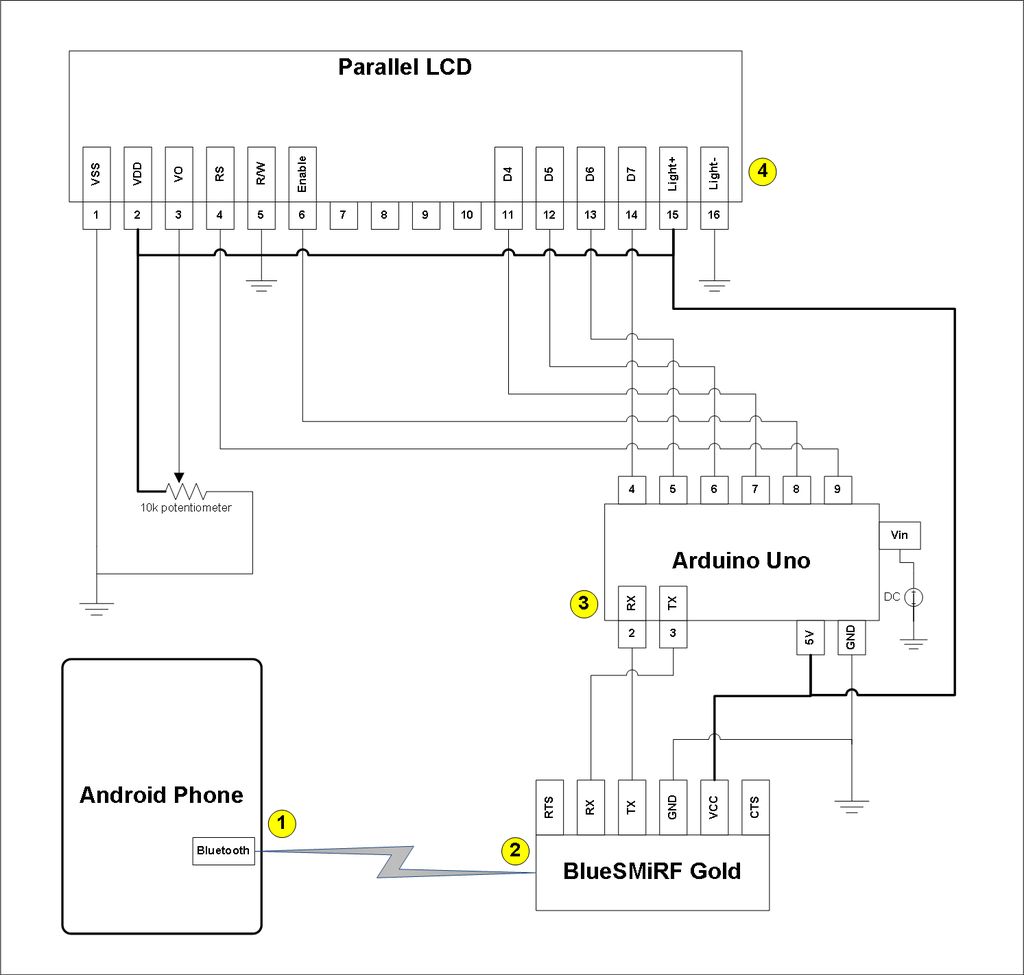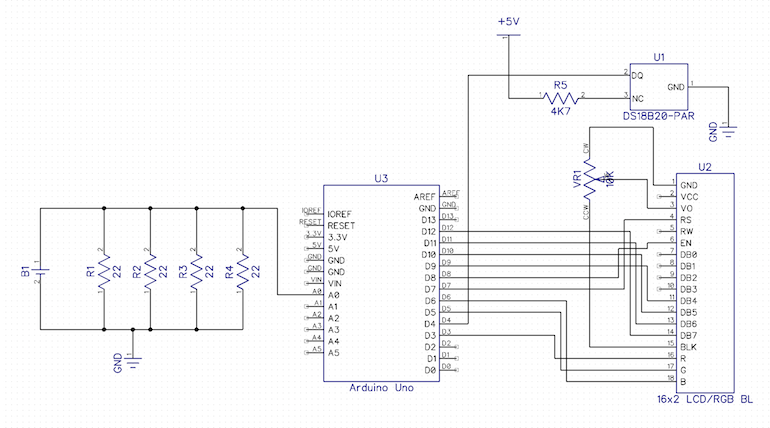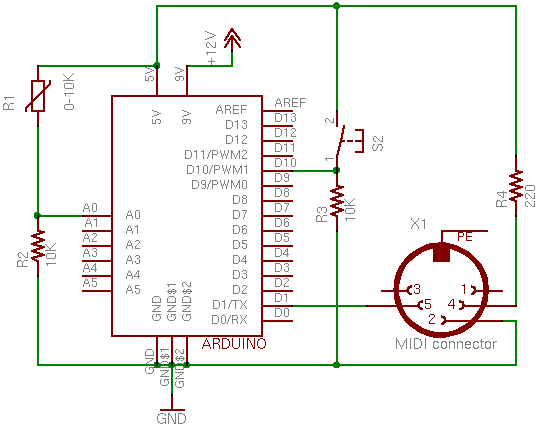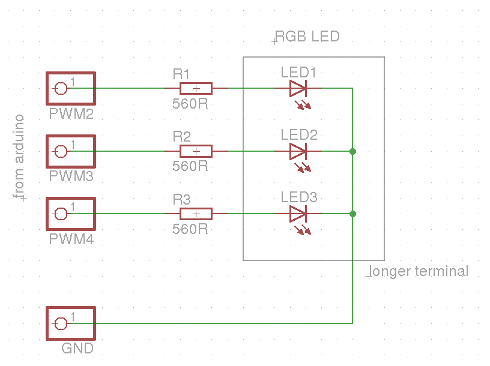
Arduino Vocal Effects Box
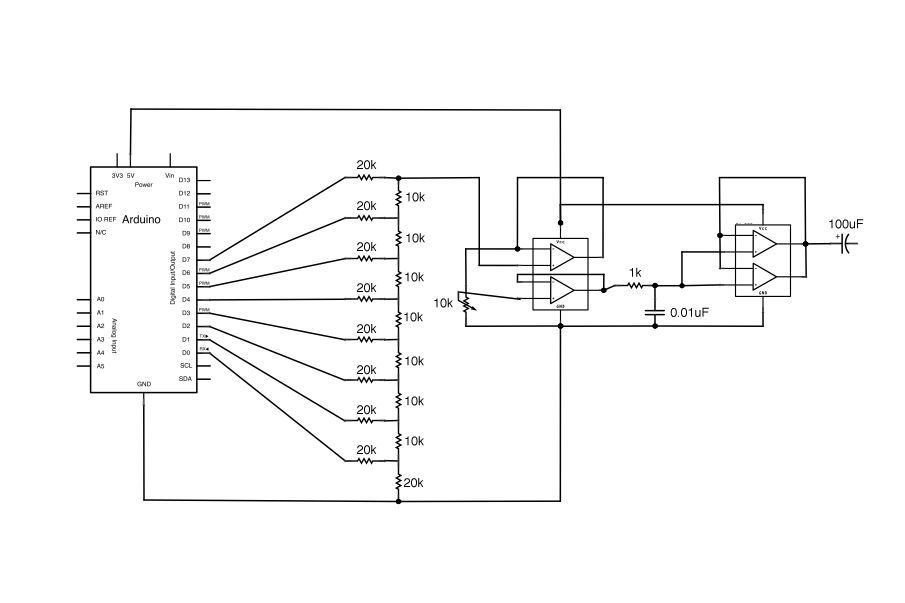
This Arduino-powered vocal effects box pitch shifts and distorts incoming audio signals to produce a wide variety of vocal effects. This project is an experiment with real-time digital signal processing using Arduino. It samples an incoming microphone signal at a rate of about 40 kHz, manipulates the audio digitally, and then outputs 8-bit audio at 40 kHz. To minimize the amount of computation required by the Arduino, a technique called granular synthesis is used to manipulate the incoming audio signal. Essentially, as audio enters the Arduino, it is divided and stored as small samples called grains, which can be as small as a millisecond or microsecond. These grains are then manipulated individually and played back; they may be lengthened or shortened, stretched or compressed, played back in reverse, copied multiple times, or mixed with other grains. Granular synthesis creates a unique type of distortion caused by discontinuities between individual grains in the outgoing signal, sometimes resulting in a "ripping" sound or introducing new frequencies into the audio that were not present before. An example of granular synthesis can be found in the works of Aphex Twin, particularly notable around the 3-minute mark of one of his tracks. Another example applied to vocals for pitch shifting and textural effects is from Paul Lansky. A notable application of this effects box is the use of subtle pitch shifting to achieve an androgynous vocal sound, inspired by the artist Fever Ray, who often pitch shifts her voice to sound somewhat masculine.
This Arduino-based vocal effects box utilizes a combination of hardware and software components to achieve real-time audio manipulation. The core of the system is an Arduino microcontroller, which serves as the processing unit. The microphone input is connected to an analog-to-digital converter (ADC) integrated within the Arduino, allowing for the sampling of the incoming audio signal at a frequency of 40 kHz. This high sampling rate is crucial for capturing the nuances of vocal performances and ensuring high-quality audio output.
Granular synthesis is implemented through a series of algorithms programmed into the Arduino. The incoming audio is segmented into small grains, which can be dynamically manipulated based on user-defined parameters. Each grain can be modified in terms of duration, pitch, and playback direction. For instance, grains can be stretched to create a slower, more ambient sound or compressed for faster playback, resulting in a unique texture. The ability to reverse playback adds an additional layer of complexity, allowing for creative sound design possibilities.
The output stage of the circuit involves a digital-to-analog converter (DAC) that translates the processed 8-bit audio back into an analog signal, which can then be sent to speakers or headphones. The design also allows for the integration of additional effects, such as reverb or delay, to further enhance the vocal processing capabilities.
The overall design emphasizes low-latency processing to ensure that the audio effects are applied in real-time, providing immediate feedback to the user. This is particularly important for live performances where timing and sound quality are critical. The compact nature of the Arduino platform allows for portability, making this vocal effects box suitable for both studio and live settings.
In conclusion, this project exemplifies the potential of using microcontrollers for advanced audio processing applications, showcasing how granular synthesis can be effectively employed to create innovative vocal effects. The exploration of pitch shifting and textural manipulation opens up new avenues for sound design, making it a valuable tool for musicians and audio engineers.This Arduino-powered vocal effects box pitch shifts and distorts incoming audio signals to produce a wide variety of vocal effects. This project is my first experiment with real-time digital signal processing using Arduino. It samples an incoming microphone signal at a rate of about 40kHz, manipulates the audio digitally, and then outputs 8 bit a
udio at 40kHz. To minimize the amount of computation required by the Arduino, I used a technique called granular synthesis to manipulate the incoming audio signal. Essentially, as audio comes into the Arduino it gets cut up and stored as small (millisecond or microsecond sized) samples called grains.
These grains are then individually manipulated and played back; they may be lengthened or shortened, stretched or compressed, played back in reverse, copied several times, or mixed with other grains. You can hear a (somewhat creepy) audio sample from the effects box below: Granular synthesis creates a unique type of distortion caused by discontinuities between individual grains in the outgoing signal.
Sometimes this distortion creates an effect I can only describe as a ripping sound, other times it introduces new frequencies into the audio that were not present before. Here is an example by Aphex Twin, the granular synthesis is especially prominent in the bridge at around 3min in.
Another example of granular synthesis, this time applied to vocals for pitch shifting and textural effects, is from Paul Lansky. My favorite thing to do with this effects box is to use subtle pitch shifting to achieve an androgynous vocal sound, I got the idea for the project after listening to copious amounts of Fever Ray this past winter, you can hear how she pitch shifts her voice to sound somewhat masculine at times.
🔗 External reference
This Arduino-based vocal effects box utilizes a combination of hardware and software components to achieve real-time audio manipulation. The core of the system is an Arduino microcontroller, which serves as the processing unit. The microphone input is connected to an analog-to-digital converter (ADC) integrated within the Arduino, allowing for the sampling of the incoming audio signal at a frequency of 40 kHz. This high sampling rate is crucial for capturing the nuances of vocal performances and ensuring high-quality audio output.
Granular synthesis is implemented through a series of algorithms programmed into the Arduino. The incoming audio is segmented into small grains, which can be dynamically manipulated based on user-defined parameters. Each grain can be modified in terms of duration, pitch, and playback direction. For instance, grains can be stretched to create a slower, more ambient sound or compressed for faster playback, resulting in a unique texture. The ability to reverse playback adds an additional layer of complexity, allowing for creative sound design possibilities.
The output stage of the circuit involves a digital-to-analog converter (DAC) that translates the processed 8-bit audio back into an analog signal, which can then be sent to speakers or headphones. The design also allows for the integration of additional effects, such as reverb or delay, to further enhance the vocal processing capabilities.
The overall design emphasizes low-latency processing to ensure that the audio effects are applied in real-time, providing immediate feedback to the user. This is particularly important for live performances where timing and sound quality are critical. The compact nature of the Arduino platform allows for portability, making this vocal effects box suitable for both studio and live settings.
In conclusion, this project exemplifies the potential of using microcontrollers for advanced audio processing applications, showcasing how granular synthesis can be effectively employed to create innovative vocal effects. The exploration of pitch shifting and textural manipulation opens up new avenues for sound design, making it a valuable tool for musicians and audio engineers.This Arduino-powered vocal effects box pitch shifts and distorts incoming audio signals to produce a wide variety of vocal effects. This project is my first experiment with real-time digital signal processing using Arduino. It samples an incoming microphone signal at a rate of about 40kHz, manipulates the audio digitally, and then outputs 8 bit a
udio at 40kHz. To minimize the amount of computation required by the Arduino, I used a technique called granular synthesis to manipulate the incoming audio signal. Essentially, as audio comes into the Arduino it gets cut up and stored as small (millisecond or microsecond sized) samples called grains.
These grains are then individually manipulated and played back; they may be lengthened or shortened, stretched or compressed, played back in reverse, copied several times, or mixed with other grains. You can hear a (somewhat creepy) audio sample from the effects box below: Granular synthesis creates a unique type of distortion caused by discontinuities between individual grains in the outgoing signal.
Sometimes this distortion creates an effect I can only describe as a ripping sound, other times it introduces new frequencies into the audio that were not present before. Here is an example by Aphex Twin, the granular synthesis is especially prominent in the bridge at around 3min in.
Another example of granular synthesis, this time applied to vocals for pitch shifting and textural effects, is from Paul Lansky. My favorite thing to do with this effects box is to use subtle pitch shifting to achieve an androgynous vocal sound, I got the idea for the project after listening to copious amounts of Fever Ray this past winter, you can hear how she pitch shifts her voice to sound somewhat masculine at times.
🔗 External reference
